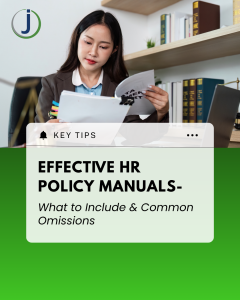An HR policy manual isn’t a binder on a shelf; it’s your company’s operating system. Done right, it removes guesswork, reinforces culture, and keeps you compliant as you grow. Done poorly (or left out-of-date), it creates confusion, inconsistent decisions, and legal risk. Here’s how to build a manual that employees actually read and leaders rely on.
 Start with purpose and audience
Start with purpose and audience
Open with a clear statement of purpose what the manual is for and how employees should use it. Keep the tone plain‑English and people‑first. Link to your mission, values, and code of conduct so policies are framed by culture, not just compliance.
Core sections every manual needs
- Employment basics: at‑will statement (where applicable), equal employment opportunity, anti‑harassment and anti‑retaliation, accommodation process, and complaint reporting paths.
- Work classification & schedules: exempt vs. non‑exempt definitions, full‑time/part‑time/temporary status, pay periods, timekeeping expectations, overtime rules, meal/rest breaks.
- Compensation & pay practices: how pay is set, promotion/merit review cadence, payroll timing, wage deductions, pay transparency where required.
- Time off & leaves: holidays, PTO/sick policies, how to request and approve time, and a summary of applicable state/local leave entitlements with links to full procedures.
- Benefits overview: eligibility, enrollment windows, qualifying life events, waiting periods; point to plan documents for details.
- Workplace conduct: professionalism, respectful workplace, conflict of interest, gifts/entertainment, substance‑free policy, workplace safety.
- Technology, security & privacy: acceptable use, password hygiene, multi‑factor authentication, device and email monitoring, confidential information, records retention.
- Remote/hybrid work: work location expectations, expense reimbursement, ergonomic/safety guidance, time‑zone and meeting norms, state tax/nexus implications.
- Performance & discipline: feedback cadence, performance improvement steps, documentation standards, termination procedures.
Version control and governance
Name an owner (HR) and a review cadence (at least annually). Log revisions with effective dates and notify staff when changes go live. Include an acknowledgment page employees sign—paper or e‑signature—to confirm they’ve read and understood the manual.
Common omissions that create headaches
- Ban‑the‑Box/background check sequencing and adverse action notice steps.
- Expense reimbursement timing (what’s covered, how to submit, and deadlines).
- Electronic monitoring disclosures and BYOD expectations.
- Social media & AI use brand voice, confidentiality, and approval workflows.
- Lactation accommodations and dedicated space requirements.
- Pay equity & salary discussion protections where applicable.
- State/local overlays (e.g., minimum wage, sick leave, predictive scheduling) for locations where you operate.
- Travel, training, and on‑call pay rules for non‑exempt staff.
- Whistleblower protections and anti‑retaliation reminders.
Rollout that drives adoption
Launch the manual with manager training, FAQs, and short how‑to videos in your self‑service portal. Keep policies searchable. Use plain‑English summaries up top with the legal detail below.
Next Steps: Want help turning policies into practice? Journey Payroll & HR can map your state overlays, align PTO/leave accruals and pay codes in your payroll system, and deliver a prioritized compliance checklist for your HR team.